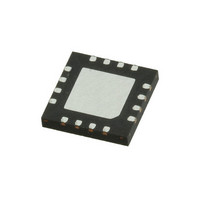MAX6694TE9A+ Maxim Integrated Products, MAX6694TE9A+ Datasheet - Page 10

MAX6694TE9A+
Manufacturer Part Number
MAX6694TE9A+
Description
IC TEMP MONITOR 5CH 16TQFN
Manufacturer
Maxim Integrated Products
Datasheet
1.MAX6694UE9A.pdf
(18 pages)
Specifications of MAX6694TE9A+
Function
Temp Monitoring System (Sensor)
Topology
ADC, Buffer, Multiplexer, Register Bank
Sensor Type
External & Internal
Sensing Temperature
-40°C ~ 125°C, External Sensor
Output Type
SMBus™
Output Alarm
Yes
Output Fan
Yes
Voltage - Supply
3 V ~ 3.6 V
Operating Temperature
-40°C ~ 125°C
Mounting Type
Surface Mount
Package / Case
16-TQFN Exposed Pad
Lead Free Status / RoHS Status
Lead free / RoHS Compliant
5-Channel Precision Temperature Monitor
with Beta Compensation
can be read from the local temperature and remote
temperature registers. The remaining 3 bits for remote
diode 1 can be read from the extended temperature
register. If extended resolution is desired, the extended
resolution register should be read first. This prevents
the most significant bits from being overwritten by new
conversion results until they have been read. If the
most significant bits have not been read within an
SMBus timeout period (nominally 37ms), normal updat-
ing continues. Table 1 shows the main temperature
register (high-byte) data format, and Table 2 shows the
extended resolution register (low-byte) data format.
If a channel’s input DXP_ and DXN_ are left open, the
MAX6694 detects a diode fault. An open diode fault
does not cause either ALERT or OVERT to assert. A bit
in the status register for the corresponding channel is
set to 1 and the temperature data for the channel is
stored as all 1s (FFh). It takes approximately 4ms for
the MAX6694 to detect a diode fault. Once a diode fault
is detected, the MAX6694 goes to the next channel in
the conversion sequence.
There are seven alarm threshold registers that store
overtemperature ALERT and OVERT threshold values.
Five of these registers are dedicated to storing one
local alert temperature threshold limit and four remote
alert temperature threshold limits (see the ALERT
Interrupt Mode section). The remaining two registers
are dedicated to remote channels 1 and 4 to store
overtemperature threshold limits (see the OVERT
Overtemperature Alarm section). Access to these regis-
ters is provided through the SMBus interface.
An ALERT interrupt occurs when the internal or external
temperature reading exceeds a high-temperature limit
(user programmable). The ALERT interrupt output signal
can be cleared by reading the status register(s) associ-
ated with the fault(s) or by successfully responding to an
alert response address transmission by the master. In
both cases, the alert is cleared but is reasserted at the
end of the next conversion if the fault condition still
exists. The interrupt does not halt automatic conversions.
10
______________________________________________________________________________________
Alarm Threshold Registers
ALERT Interrupt Mode
Diode Fault Detection
The ALERT output is open-drain so that multiple devices
can share a common interrupt line. All ALERT interrupts
can be masked using the configuration 2 register. The
POR state of these registers is shown in Table 3.
The SMBus alert response interrupt pointer provides
quick fault identification for simple slave devices that
lack the complex logic needed to be a bus master.
Upon receiving an interrupt signal, the host master can
broadcast a receive byte transmission to the alert
response slave address (see the Slave Address sec-
tion). Then, any slave device that generated an inter-
rupt attempts to identify itself by putting its own
address on the bus.
The alert response can activate several different slave
devices simultaneously, similar to the I
If more than one slave attempts to respond, bus arbitra-
tion rules apply, and the device with the lower address
code wins. The losing device does not generate an
acknowledgment and continues to hold the ALERT line
low until cleared. (The conditions for clearing an alert
vary depending on the type of slave device.)
Successful completion of the alert response protocol
clears the output latch. If the condition that caused the
alert still exists, the MAX6694 reasserts the ALERT
interrupt at the end of the next conversion.
The MAX6694 has two overtemperature registers that
store remote alarm threshold data for the OVERT output.
OVERT is asserted when a channel’s measured temper-
ature is greater than the value stored in the correspond-
ing threshold register. OVERT remains asserted until the
temperature drops below the programmed threshold
minus 4°C hysteresis. An overtemperature output can
be used to activate a cooling fan, send a warning, initi-
ate clock throttling, or trigger a system shutdown to pre-
vent component damage. See Table 3 for the POR state
of the overtemperature threshold registers.
The 8-bit command byte register (Table 3) is the master
index that points to the various other registers within the
MAX6694. This register’s POR state is 0000 0000.
OVERT Overtemperature Alarms
ALERT Response Address
Command Byte Functions
2
C General Call.











